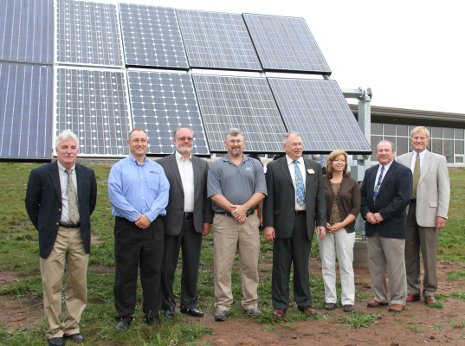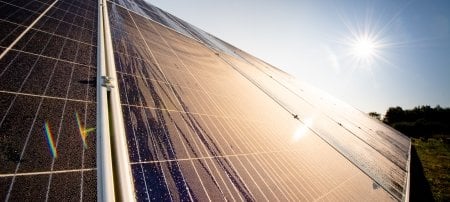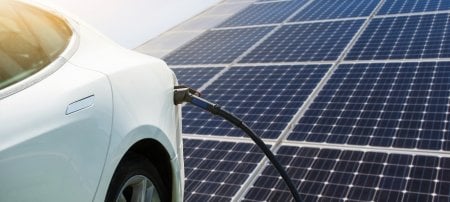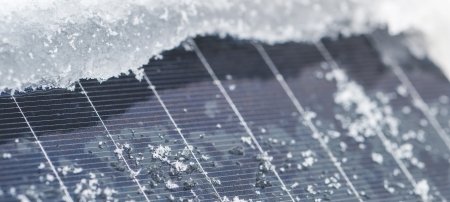Michigan Tech Dedicates New Solar Energy Research Facility

It was a damp and cloudy day, but the solar panels were still churning out electricity today as the Keweenaw Research Center dedicated the new Michigan Tech Solar Photovoltaic Research Facility.
“It’s amazing what free energy is out there to gather up,” KRC Director Jay Meldrum told the crowd jamming the conference room in KRC’s Engineering Building.
The two-kilowatt system generates enough energy to charge all of the electric snowmobiles competing in the SAE Clean Snowmobile Challenge, held every year at KRC, but that’s just a bonus. The system’s two main purposes are to support research in photovoltaic systems and to introduce student engineers to solar technologies.
Because the facility includes a variety of solar panels, researchers can compare their performance. And scientists don’t necessarily have to be on site: Just inside the building, a monitor displays a detailed, 24/7 flow of data from each of the modules mounted just outside. All that information will soon be free and available on the Internet.
The possibilities go far beyond solar panel design, Meldrum said. Researchers can investigate how the facility integrates with the larger electric grid, the economics of solar power, and all the system’s other components.
The facility is state of the art, in part because SolarBridge Technologies, of Austin, Texas, has donated 10 microinverters. They are attached to each of the modules and convert each panel’s DC current into AC current compatible with household use.
Those microinverters are key, said two faculty members who expect to use the facility in their research. “The cool thing about this is the inverters,” said Bruce Mork, a professor of electrical and computer engineering. “You don’t need batteries. They allow you to connect directly into your local grid.”
Joshua Pearce agreed. “This is plug and play,” said Pearce, an associate professor of materials science and engineering and electrical and computer engineering. Microinverters help drive down the price of solar energy and make it more and more attractive to a mass market. As a result, “solar can now play ball in places where electricity is costly, like Hawaii,” he said.
Ron Van Dell, president and CEO of SolarBridge and a 1979 electrical engineering graduate of Michigan Tech, predicted that the facility will help drive solar power closer to wide-spread use. “This will be a fruitful area for research,” he said, adding that he expected the program to draw investigators from many disciplines, including business.
With an annual snowfall averaging 200-plus inches, this might not seem like the ideal spot to study photovoltaic systems. But SolarBridge tests their equipment in all kinds of conditions, from Antarctica to the American West. Snow can actually be a benefit, Van Dell said, since it reflects sunlight.
The facility has an added advantage for Michigan Tech: it may also bring more top researchers here. “The timing of this couldn’t be better,” said University President Glenn D. Mroz. “As we continue to fill positions in the Strategic Faculty Hiring Initiative in Next-Generation Energy Systems, this facility lets us demonstrate to potential faculty members that they can be successful here.”
Dow Corning, of Midland, and Hemlock Semiconductor, a partially owned subsidiary of Dow Corning based in Hemlock, donated the facility’s solar panels, which were made by a number of manufacturers. Dow Corning produces the silicones used in making the panels. Hemlock Semiconductor manufactures polycrystalline silicon, the black, glass-like material on the panels’ surface that absorbs sunlight.
“We’re proud and happy this has worked out so well,” said Bill Huss, global productivity manager for Dow Corning and a 1983 chemical engineering graduate. He addressed the students in the crowd: “One of the primary reasons we’re doing this is for you,” he said. Steve Trombley, a 1989 mechanical engineering graduate and reliability team leader at Hemlock Semiconductor, agreed. “The main reason we want to do this is for students, to get you excited about working in solar energy and maybe inspire you to work for a great company like Dow Corning or Hemlock Semiconductor.”
Undergraduates in Michigan Tech’s Alternative Fuels Group Enterprise will be among the first to get involved in the new research facility. KRC has a small weather station at the site, and the students will correlate the solar cells’ output with the local weather, monitoring how they behave under varying conditions.
With so much interest in the new facility, Meldrum forecast a bright future, despite the gloomy weather. “This will be a great research station,” he said.
Pictured above by the Michigan Tech Solar Photovoltaic Research Facility are Bill Huss of Dow Corning; David Kraycsir, Hemlock Semiconductors; Ron Van Dell, SolarBridge; Steve Trombley, Hemlock Semiconductors; Jay Meldrum, Keweenaw Research Center director; Mary Fogelsinger-Huss of Dow Corning; Brian Hannon, Michigan Tech Fund; and Michigan Tech President Glenn Mroz. Emil Groth photo
Michigan Technological University is a public research university founded in 1885 in Houghton, Michigan, and is home to more than 7,000 students from 55 countries around the world. Consistently ranked among the best universities in the country for return on investment, Michigan’s flagship technological university offers more than 120 undergraduate and graduate degree programs in science and technology, engineering, computing, forestry, business and economics, health professions, humanities, mathematics, social sciences, and the arts. The rural campus is situated just miles from Lake Superior in Michigan's Upper Peninsula, offering year-round opportunities for outdoor adventure.




Comments